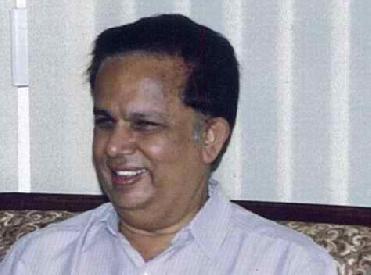
File photo of ISRO chief G Madhavan Nair
BANGALORE (BNS): For the first time in Indian space history, a spacecraft has broken away from the Earth�s gravitational field and approached the moon today. Chandrayaan-1, India�s first unmanned spacecraft mission to moon entered the lunar orbit Saturday.
The historic event occurred following the firing of Chandrayaan-1 spacecraft�s liquid engine at 16:51 IST for a duration of 817 seconds, according to an Indian Space Research Organisation (ISRO) statement.
�The highly complex �lunar orbit insertion manoeuvre� was performed from Chandrayaan-1 Spacecraft Control Centre of ISRO Telemetry, Tracking and Command Network at Bangalore,� ISRO said.
Heaving a sigh of relief, ISRO chief G Madhavan Nair said today's operation was the "most critical moment" in the mission.
"We have done it," a visibly happy Nair declared.
"For the last 20 minutes, almost all our hearts were at a standstill," Nair said from a ground centre near Bangalore.
The spacecraft, launched on October 22, had been placed in the Lunar Transfer Trajectory on November 4.
Indian Deep Space Network (IDSN) at Byalalu supported the crucial task of transmitting commands and continuously monitoring �this vital event� with two dish antennas, one measuring 18 m and the other 32 m.
Chandrayaan-1�s liquid engine was fired when the spacecraft passed at a distance of about 500 km from the moon to reduce its velocity to enable lunar gravity to capture it into an orbit around the moon.
The spacecraft is now orbiting the moon in an elliptical orbit that passes over the polar regions of the moon. The nearest point of this orbit (periselene) lies at a distance of about 504 km from the moon�s surface while the farthest point (aposelene) lies at about 7502 km. Chandrayaan-1 takes about 11 hours to go round the moon once in this orbit.
According to ISRO, the performance of all the systems onboard Chandrayaan-1 is normal. In the coming days, the height of Chandrayaan-1 spacecraft�s orbit around the moon will be carefully reduced in steps to achieve a final polar orbit of about 100 km height from the moon�s surface. Following this, the Moon Impact Probe (MIP) of the spacecraft will be released to hit the lunar surface. Later, the other scientific instruments will be turned on sequentially leading to the normal phase of the mission.
Chandrayaan-1 spacecraft was launched on October 22, 2008 by PSLV-C11 from India�s spaceport at Satish Dhawan Space Centre (SDSC) SHAR, Sriharikota. As intended, PSLV placed the spacecraft in a highly oval shaped orbit with a perigee (nearest point to Earth) of 255 km and an apogee (farthest point to Earth) of 22,860 km.
In the past two weeks, the liquid engine of Chandrayaan-1 has been successfully fired five times at opportune moments to increase the apogee height, first to 37,900 km, then to 74,715 km, later to 164,600 km, after that to 267,000 km and finally to 380,000km, as planned. During this period, the Terrain Mapping Camera (TMC), one of the eleven payloads (scientific instruments) of the spacecraft, was successfully operated twice to take the pictures, first of the Earth, and then moon.
With today�s successful manoeuvre, India becomes the fifth country to send a spacecraft to Moon. The other countries, which have sent spacecraft to Moon, are the United States, former Soviet Union, Japan and China. Besides, the European Space Agency (ESA), a consortium of 17 countries, has also sent a spacecraft to moon.
 Next Article
Next Article













The Indian Air Force, in its flight trials evaluation report submitted before the Defence Ministry l..
view articleAn insight into the Medium Multi-Role Combat Aircraft competition...
view articleSky enthusiasts can now spot the International Space Station (ISS) commanded by Indian-American astr..
view article